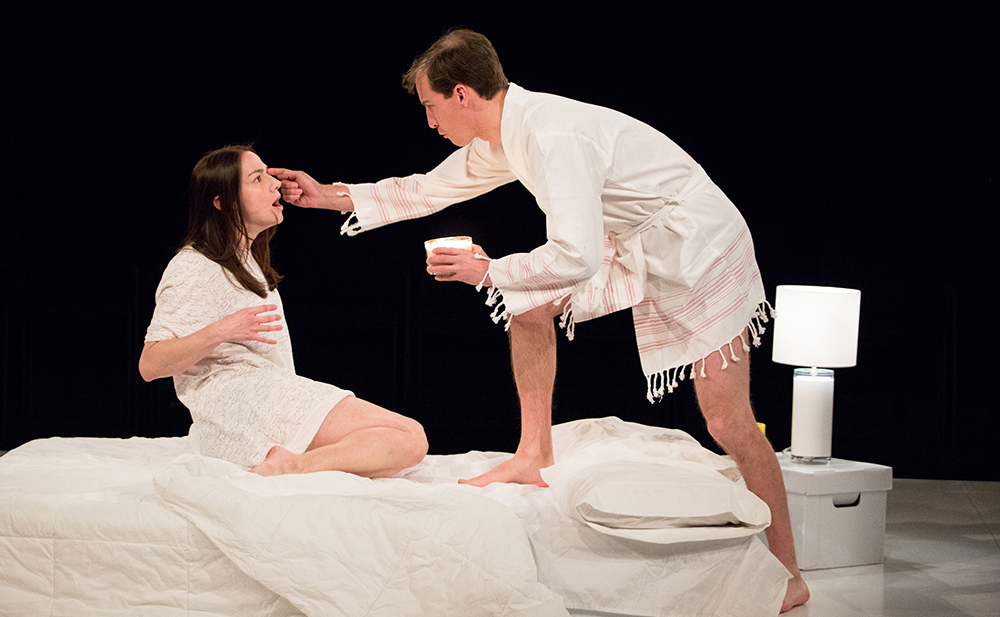
The Hard Problem. By Tom Stoppard. Wilma Theatre production directed by Blanka Zizka, 2016.
This Tom Stoppard play is impressively erudite. With this playwright, that’s to be expected, as in Arcadia, The Invention of Love and The Coast of Utopia. But it lacks the depth of those classics.
Instead of delving into history as he did with them, this time Stoppard confronts a contemporary dilemma among researchers. The quandary—the “hard problem”—is whether the mind is the same as the brain. Is there a conscience that transcends grey matter and brain waves? This discussion segues into a debate about the existence of God, and whether coincidences occur by chance or by divine ordination.
In this regard, The Hard Problem reminds me of George Bernard Shaw’s Man and Superman link where the characters argued about morality, God, heaven and hell. Except the roles are reversed. Shaw’s protagonist was an atheist in the midst of a society that professed religious faith. Stoppard has created a central character who believes in God while everyone around her is a skeptic.
GBS made his points in a voice that readers and playgoers recognized as his own, although he put his thoughts into the lips of his characters. In his better plays, Stoppard created real human beings, more dimensional than any by Shaw. (Although Shaw clothed his arguments with more insouciant wit.) But here Stoppard presents characters who seem like talking heads in a debating contest. The protagonist, Hilary, is intelligent and attractive. She grieves for the baby she gave up for adoption, and prays to God, and upholds the idea of absolute morality.
Hilary is a university psychology student who applies for a job at an American-backed corporation which investigates artificial intelligence, the Krohl Institute for Brain Science. Given her beliefs, we wonder why Hilary wants to work at this type of place, and why she was hired.
Her university mentor and bed partner, Spike, mocks mother-child affection and calls Raphael’s Madonna and Child “Woman Maximizing Gene Survival.” His arguments are a foil for Hilary’s and, in contrast to her, he’s a cynic.
After Hilary’s rival applicant for the job, Amal, loses out to her he becomes a hedge-funder who analyzes and predicts global markets. Amal errs in ignoring “outlier” results that don’t fit his models, and that leads to a financial crash. Stoppard hints that the whole world works similarly.
A major plot twist was predictable. When Hilary has just told us she had a daughter that she gave away for adoption, whom she thinks about every day, and who would now be age 13; and then we see her boss with a smart 13-year-old daughter—who could not see what’s coming? On top of that, the boss had talked about coincidence, and made the point that sometimes coincidence is just a lack of all the necessary information.
Blanka Zizka’s production was noticeably different from Nicholas Hytner’s original in England, especially in two regards. She staged The Hard Problem on a split stage—with rows of patrons seated at the rear, behind the actors—reinforcing Stoppard’s point that there are two sides to “the problem.” The other was taking musical bridges specified in the script as Bach (whose music is intellectual) and changing them to jazz saxophone, connoting soul. Those seem like appropriate responses to the story. Michael Pedicin was the superb saxophonist.
Sarah Gliko was persuasive as a temptress but not as a research scientist. (In fact, her physical attractiveness seems to be why she was hired over Amal.) Ross Beschler was properly overbearing as her mentor, as was Shravan Amin as Amal. Steven Rishard was particularly good as the head of the institute, an interesting character who was a kind patriarch at home and an overbearing boss in his office. Taysha Canales, Jeena Yi, Krista Apple-Hodge, Gaby Bradbury and Lindsay Smiling adequately filled other rolls which, unfortunately, included stereotypical lesbians and super-smart Asian and Indian.
Despite its shortcomings, Stoppard’s script is full of gems. One of my favorite moments is Amal’s oration about how the stockmarket is similar to human behavior: “The market is a stream of rational acts by self-interested people, so risk ought to be computable, and the models can be proved mathematically to crash about once in the lifetime of the universe. But every now and then, the market’s behavior becomes irrational, as though it’s gone mad, or fallen in love.”
Please share your thoughts and your opinions with us. Address to editor@theculturalcritic.com
Read other reviews on The Cultural Critic